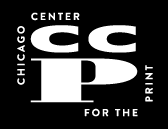| Alfonso Iannelli (1886-1965), born in the small town of Andretta, Italy, came to the U.S. at the age of 12, and approximately 5 years later won a scholarship to the Art Students League in New York. Adept at both painting and sculpture, he started his career in commercial graphic design, opening his own studio where, by 1907, he was contributing drawings to Harper's and The Ladies Home Journal. In 1910, he went to Los Angeles, and opened a design studio. Soon afterwards, the builders of the new Orpheum theater asked him to paint lobby "showcards" (at $5.00 a piece) for the traveling vaudeville acts. Iannelli couldn't have known at the time, at the age of 24, that his new job designing the lobby window for Los Angeles' new Orpheum Vaudeville Theater could lead to his breakthrough into Modernism. Iannelli's Orpheum posters gave vaudeville audiences a tangible advertisement for a new Modernism just flowering in avant-garde circles. The vibrant, geometrized figures he painted to represent the usual dog acts, comedians, dancers and singers on the circuit lines the theater's lobby with abstractions never before seen by Los Angeles theatergoers. |
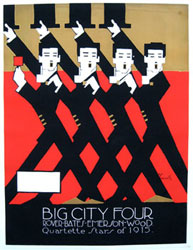 |
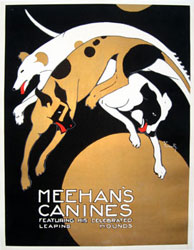 |
The poster's design conveyed the spirit and energy of the performers, instead of simple caricatures. If art is, essentially, language, then Iannelli was creating a new dialect with geometry as it's grammar. Although people were considering cubism the "newest thing", according to Iannelli it was really the oldest method of expressionism in the world. Iannelli explained how the Egyptians, the Japanese, the Aztecs and the North American Indians had all utilized the geometric forms of the circle, triangle and square, derived from such natural phenomena as the shape of the sun. | 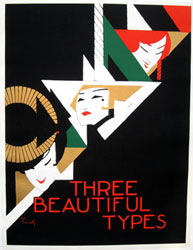 |
||
| This brief explanation of Iannelli's Orpheum posters would not be complete without mention of his wife. Margaret Spaulding, who lived in Los Angeles at the time, was a teenaged student of his who possessed an innate talent for illustration and a like-minded interest in Modernism. She joined him in his studio in 1913 and they found a design harmony in working together. During Iannelli's stay in Chicago, working with Frank Lloyd Wright, Margaret continued work on the posters for the Orpheum, and the designs began to show more of her artistic influence based on the principals of Art Nouveau and the Viennese Secessionism movement. When Alfonso returned to Los Angeles, the Orpheum posters "displayed a new aesthetic of geometric complexity…. flat geometric areas of solid color predominated the designs, often contrasting with areas of gold and jet black". On Valentine's Day 1915, Alfonso & Margaret married in California. Soon afterwards, they moved to Chicago setting up their studio at Michigan Ave. & Madison St., eventually moving it to Park Ridge, Illinois. |
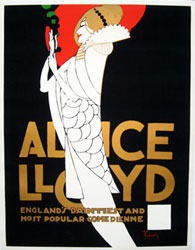 |
 |
Iannelli was thought to have created some one hundred posters for the Orpheum Theater between 1912 and 1915. And though his friends urged their publication he resisted, not wanting to be tainted forever as a "poster-man". It was this need to be seen as an original artist that ironically buried his future reputation for generations. If only he had allowed his images to multiply throughout the Orpheum circuit or in later publication, the posters he created in that span would have certainly been rediscovered during the boom years of the 1960's! And "Iannelli", so artfully lettered in the corners of each of these lobby sheets, would have meant gold to the later generations of collectors, ranking with A. M. Cassandre, Will Beadley, or Alphonse Mucha. Alfonso Iannelli's Orpheum posters place him squarely at the vanguard of American Modernism when the 1913 New York Armory Show officially gave birth to the concept of "Modern Art" in America. |
| " Alfonso Iannelli's current reputation illustrates the paradox of how an artist can at once be illustrious and unknown. In the Chicago area, he created the sculpture for Frank Lloyd Wright's Midway Gardens, worked on many apartments & homes with architect Barry Byrne, contributed much of the Pickwick Theater, added bronze plaques to The Adler Planetarium, designed several structures for the Century of Progress Exposition, and ultimately carved the Rock of Gibraltar onto the side of the Prudential Building. During Iannelli's life (1888-1965) those achievements and more were examined in five exhibitions at the Art Institute of Chicago.." Alan Artner- Chicago Tribune Art Critic 9/27/01 This series of 6 Orpheum Theater posters were produced, with the estates permission, by The Chicago Architecture Foundation in 1968 as a limited- edition fund raising posters. They are extremely rare and The Chicago Center for The Print has recently acquired the complete series. |
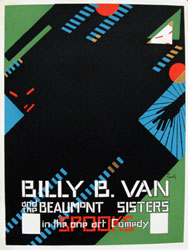 |
